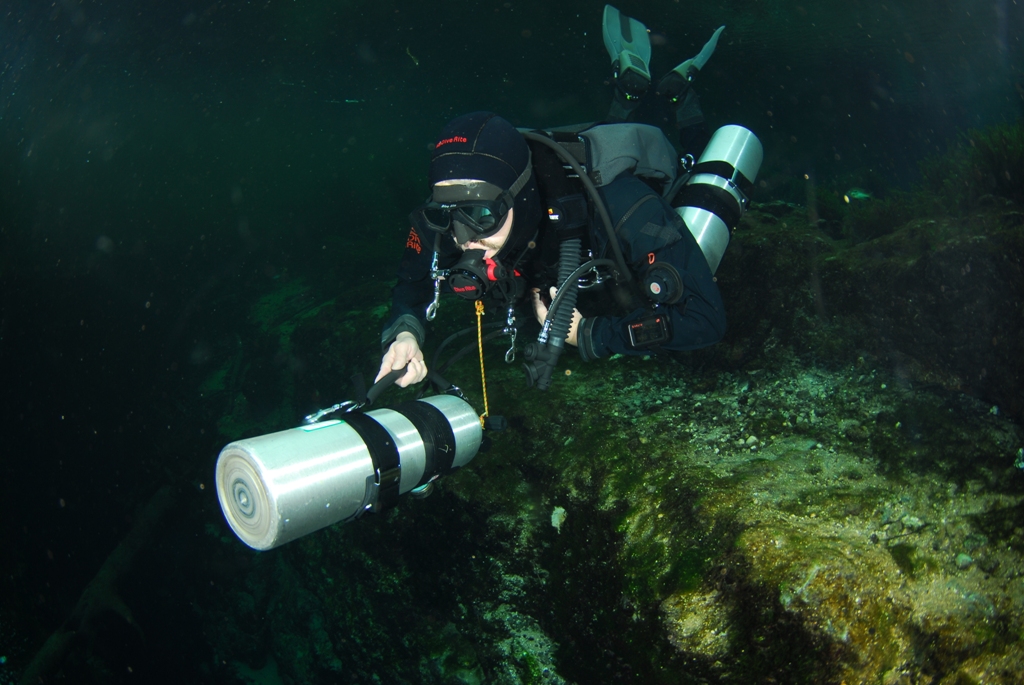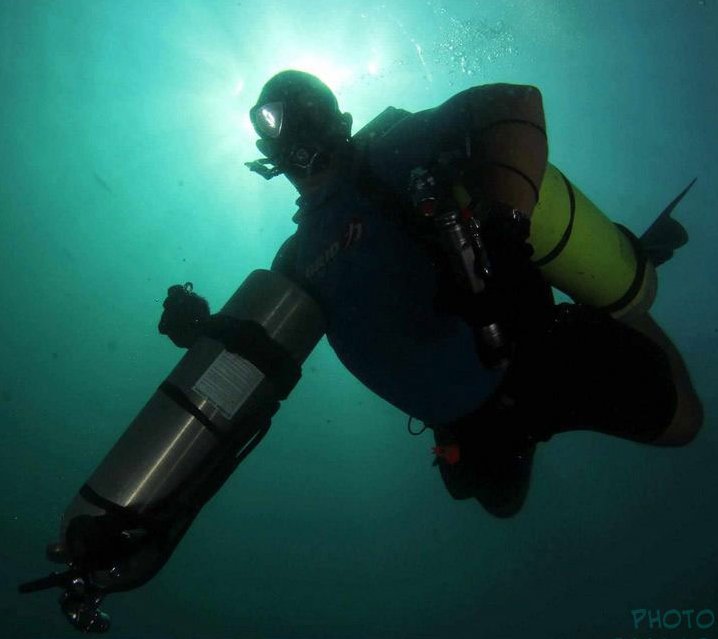|
Sidemount
Sidemount is a scuba diving equipment configuration which has scuba sets mounted alongside the diver, below the shoulders and along the hips, instead of on the back of the diver. It originated as a configuration for advanced cave diving, as it facilitates penetration of tight sections of cave, allows easy access to cylinder valves, provides easy and reliable gas redundancy, and tanks can be easily removed when necessary. These benefits for operating in confined spaces were also recognized by divers who conducted technical wreck diving penetrations. Sidemount diving is now growing in popularity within the technical diving community for general decompression diving, and is becoming an increasingly popular specialty training for recreational diving, with several diver certification agencies offering recreational and technical level sidemount training programs. Terminology ;Sidemount diving: Sidemount diving is the practice of diving with two or more cylinders secured at t ... [...More Info...] [...Related Items...] OR: [Wikipedia] [Google] [Baidu] |
Sidemount 032 Photo By Pete Nawrocky
Sidemount is a scuba diving equipment configuration which has scuba sets mounted alongside the diver, below the shoulders and along the hips, instead of on the back of the diver. It originated as a configuration for advanced cave diving, as it facilitates penetration of tight sections of cave, allows easy access to cylinder valves, provides easy and reliable gas redundancy, and tanks can be easily removed when necessary. These benefits for operating in confined spaces were also recognized by divers who conducted technical wreck diving penetrations. Sidemount diving is now growing in popularity within the technical diving community for general decompression diving, and is becoming an increasingly popular specialty training for recreational diving, with several diver certification agencies offering recreational and technical level sidemount training programs. Terminology ;Sidemount diving: Sidemount diving is the practice of diving with two or more cylinders secured at t ... [...More Info...] [...Related Items...] OR: [Wikipedia] [Google] [Baidu] |
Sidemount Cylinder Partial Removal-crop
Sidemount is a scuba diving equipment configuration which has scuba sets mounted alongside the diver, below the shoulders and along the hips, instead of on the back of the diver. It originated as a configuration for advanced cave diving, as it facilitates penetration of tight sections of cave, allows easy access to cylinder valves, provides easy and reliable gas redundancy, and tanks can be easily removed when necessary. These benefits for operating in confined spaces were also recognized by divers who conducted technical wreck diving penetrations. Sidemount diving is now growing in popularity within the technical diving community for general decompression diving, and is becoming an increasingly popular specialty training for recreational diving, with several diver certification agencies offering recreational and technical level sidemount training programs. Terminology ;Sidemount diving: Sidemount diving is the practice of diving with two or more cylinders secured at t ... [...More Info...] [...Related Items...] OR: [Wikipedia] [Google] [Baidu] |
Sidemount Detail Top Of Cylinder DSC 0020 Photo By Pete Nawrocky
Sidemount is a scuba diving equipment configuration which has scuba sets mounted alongside the diver, below the shoulders and along the hips, instead of on the back of the diver. It originated as a configuration for advanced cave diving, as it facilitates penetration of tight sections of cave, allows easy access to cylinder valves, provides easy and reliable gas redundancy, and tanks can be easily removed when necessary. These benefits for operating in confined spaces were also recognized by divers who conducted technical wreck diving penetrations. Sidemount diving is now growing in popularity within the technical diving community for general decompression diving, and is becoming an increasingly popular specialty training for recreational diving, with several diver certification agencies offering recreational and technical level sidemount training programs. Terminology ;Sidemount diving: Sidemount diving is the practice of diving with two or more cylinders secured at t ... [...More Info...] [...Related Items...] OR: [Wikipedia] [Google] [Baidu] |
Sidemount Diving Skills-crop
Sidemount is a scuba diving equipment configuration which has scuba sets mounted alongside the diver, below the shoulders and along the hips, instead of on the back of the diver. It originated as a configuration for advanced cave diving, as it facilitates penetration of tight sections of cave, allows easy access to cylinder valves, provides easy and reliable gas redundancy, and tanks can be easily removed when necessary. These benefits for operating in confined spaces were also recognized by divers who conducted technical wreck diving penetrations. Sidemount diving is now growing in popularity within the technical diving community for general decompression diving, and is becoming an increasingly popular specialty training for recreational diving, with several diver certification agencies offering recreational and technical level sidemount training programs. Terminology ;Sidemount diving: Sidemount diving is the practice of diving with two or more cylinders secured at t ... [...More Info...] [...Related Items...] OR: [Wikipedia] [Google] [Baidu] |
Sidemount Cylinder Set With Regulators FittedP9230009
Sidemount is a scuba diving equipment configuration which has scuba sets mounted alongside the diver, below the shoulders and along the hips, instead of on the back of the diver. It originated as a configuration for advanced cave diving, as it facilitates penetration of tight sections of cave, allows easy access to cylinder valves, provides easy and reliable gas redundancy, and tanks can be easily removed when necessary. These benefits for operating in confined spaces were also recognized by divers who conducted technical wreck diving penetrations. Sidemount diving is now growing in popularity within the technical diving community for general decompression diving, and is becoming an increasingly popular specialty training for recreational diving, with several diver certification agencies offering recreational and technical level sidemount training programs. Terminology ;Sidemount diving: Sidemount diving is the practice of diving with two or more cylinders secured at the ... [...More Info...] [...Related Items...] OR: [Wikipedia] [Google] [Baidu] |
Scuba Sets
A scuba set, originally just scuba, is any breathing apparatus that is entirely carried by an underwater diver and provides the diver with breathing gas at the ambient pressure. ''Scuba'' is an anacronym for self-contained underwater breathing apparatus. Although strictly speaking the scuba set is only the diving equipment that is required for providing breathing gas to the diver, general usage includes the harness by which it is carried, and those accessories which are integral parts of the harness and breathing apparatus assembly, such as a jacket or wing style buoyancy compensator and instruments mounted in a combined housing with the pressure gauge, and in the looser sense, it has been used to refer to all the diving equipment used by the scuba diver, though this would more commonly and accurately be termed scuba equipment or scuba gear. Scuba is overwhelmingly the most common underwater breathing system used by recreational divers and is also used in professional diving whe ... [...More Info...] [...Related Items...] OR: [Wikipedia] [Google] [Baidu] |
Scuba Diving
Scuba diving is a mode of underwater diving whereby divers use breathing equipment that is completely independent of a surface air supply. The name "scuba", an acronym for " Self-Contained Underwater Breathing Apparatus", was coined by Christian J. Lambertsen in a patent submitted in 1952. Scuba divers carry their own source of breathing gas, usually compressed air, affording them greater independence and movement than surface-supplied divers, and more time underwater than free divers. Although the use of compressed air is common, a gas blend with a higher oxygen content, known as enriched air or nitrox, has become popular due to the reduced nitrogen intake during long and/or repetitive dives. Also, breathing gas diluted with helium may be used to reduce the likelihood and effects of nitrogen narcosis during deeper dives. Open circuit scuba systems discharge the breathing gas into the environment as it is exhaled, and consist of one or more diving cylinders containing br ... [...More Info...] [...Related Items...] OR: [Wikipedia] [Google] [Baidu] |
Diving Rebreather
A Diving rebreather is an underwater breathing apparatus that absorbs the carbon dioxide of a diver's exhaled breath to permit the rebreathing (recycling) of the substantially unused oxygen content, and unused inert content when present, of each breath. Oxygen is added to replenish the amount metabolised by the diver. This differs from open-circuit breathing apparatus, where the exhaled gas is discharged directly into the environment. The purpose is to extend the breathing endurance of a limited gas supply, and, for covert military use by frogmen or observation of underwater life, to eliminate the bubbles produced by an open circuit system. A diving rebreather is generally understood to be a portable unit carried by the user, and is therefore a type of self-contained underwater breathing apparatus (scuba). A semi-closed rebreather carried by the diver may also be known as a gas extender. The same technology on a submersible or surface installation is more likely to be referred ... [...More Info...] [...Related Items...] OR: [Wikipedia] [Google] [Baidu] |
Cave Diving
Cave-diving is underwater diving in water-filled caves. It may be done as an extreme sport, a way of exploring flooded caves for scientific investigation, or for the search for and recovery of divers or, as in the 2018 Thai cave rescue, other cave users. The equipment used varies depending on the circumstances, and ranges from breath hold to surface supplied, but almost all cave-diving is done using scuba equipment, often in specialised configurations with redundancies such as sidemount or backmounted twinset. Recreational cave-diving is generally considered to be a type of technical diving due to the lack of a free surface during large parts of the dive, and often involves planned decompression stops. A distinction is made by recreational diver training agencies between cave-diving and cavern-diving, where cavern diving is deemed to be diving in those parts of a cave where the exit to open water can be seen by natural light. An arbitrary distance limit to the open water sur ... [...More Info...] [...Related Items...] OR: [Wikipedia] [Google] [Baidu] |
Scuba Schools International
Scuba Schools International (SSI) is a for-profit organization that teaches the skills involved in scuba diving and freediving, and supports dive businesses and resorts. SSI has over 2,500 authorized dealers, 35 regional centers, and offices all over the world. History SSI was founded by Robert Clark in 1970. SSI headquarters are in Fort Collins, Colorado, and it is owned by Concept Systems International, Inc. In 2008, it was acquired by Doug McNeese, owner of the National Association of Scuba Diving Schools (USA) until its merger with SSI in 1999, and Robert Stoss, manager of Scubapro and Seemann Sub. On January 1, 2014, SSI was acquired by HEAD, which also includes the Mares brand of diving equipment, HEAD NV, for €4.9m. Training SSI offers internationally recognized recreational diver training programs - starting with snorkeling and entry level scuba diving courses up to instructor certifications. The most common programs are: SSI Open Water Diver (OWD) and Advanced ... [...More Info...] [...Related Items...] OR: [Wikipedia] [Google] [Baidu] |
Technical Diving International
Technical Diving International (TDI) claims to be the largest technical diving certification agency in the world, and one of the first agencies to offer mixed gas and rebreather training. TDI specializes in more advanced Scuba diving techniques, particularly diving with rebreathers and use of breathing gases such as trimix and heliox. TDI provides courses and certification for divers and for instructors. TDI history TDI was founded in 1994 by Bret Gilliam, David Sipperly and Mitch Skaggs after a split away from International Association of Nitrox and Technical Divers (IANTD) in 1993. The agency aimed to provide training materials and education for specialized diving situations. Some courses offered by TDI include open circuit courses such as diving with Nitrox as well as Rebreather courses. They also provide training for overhead environments like caves and wrecks, mixed gas training and were one of the first diving agencies to create a comprehensive insurance plan for t ... [...More Info...] [...Related Items...] OR: [Wikipedia] [Google] [Baidu] |
Recreational Diving
Recreational diving or sport diving is diving for the purpose of leisure and enjoyment, usually when using scuba equipment. The term "recreational diving" may also be used in contradistinction to "technical diving", a more demanding aspect of recreational diving which requires more training and experience to develop the competence to reliably manage more complex equipment in the more hazardous conditions associated with the disciplines. Breath-hold diving for recreation also fits into the broader scope of the term, but this article covers the commonly used meaning of ''scuba diving for recreational purposes, where the diver is not constrained from making a direct near-vertical ascent to the surface at any point during the dive'', and risk is considered low. The equipment used for recreational diving is mostly open circuit scuba, though semi closed and fully automated electronic closed circuit rebreathers may be included in the scope of recreational diving. Risk is managed by ... [...More Info...] [...Related Items...] OR: [Wikipedia] [Google] [Baidu] |









